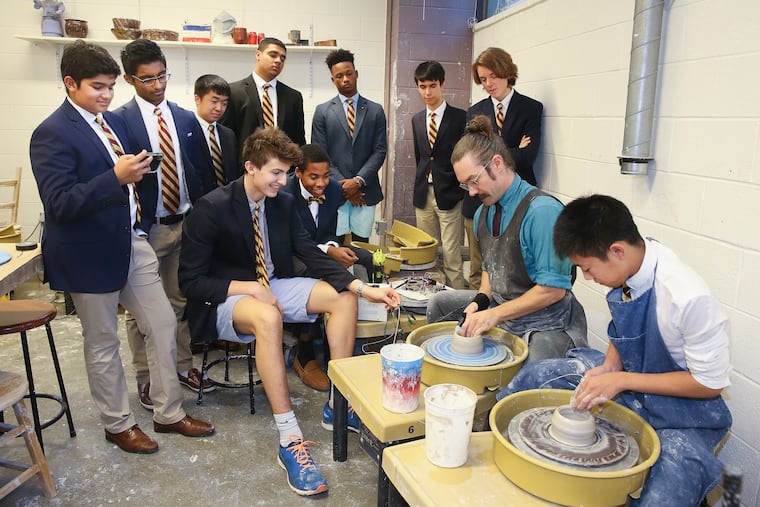Main Line science kids’ winning formula: Wet clay, soft robots
A high-tech device for teaching students the intricacies of using a pottery wheel — a glove with pneumatic actuators to steer a learner's hand to mimic the movements of a skilled teacher — gained Haverford's Soft Robotics Team its second-straight top honors at this year's Soft Robotics Design Competition sponsored by Harvard University.

The science whizzes of the Haverford School's Soft Robotics Team knew that following up the sweet taste of 2017's first-place victory for designing soft robots made from gummy-bear-like candy wouldn't be an easy second course.
But it turns out winning still fits them like a glove – literally.
A high-tech device for teaching students the intricacies of throwing clay pots — a glove with pneumatic actuators to steer a learner's hand to mimic the movements of a skilled teacher — gained the team top honors at this year's Soft Robotics Design Competition at Harvard University. It was the second consecutive year the team scored gold.
"I don't have to be in the room," said Haverford ceramics teacher Jacob Raeder, describing how he can wear the device and direct a student's untrained hands. "It's almost as if it's training wheels."
Haverford's growing domination in the lab comes from both its pool of eager, science-loving kids and the guidance of a one-of-a-kind coach, engineering teacher Holly Golecki, who oversees the team.
"We need more teachers like her," Adam Stokes — a lecturer at the University of Edinburgh's school of engineering, who met Golecki and her young charges at an engineering conference this year — said in an email. He said molding the next generation of innovators depends on people "who are willing to forgo a scientific research career" to teach.
As for the students' back-to-back wins, he said, "Children have not yet been blinkered by the pursuit of 'scientific excellence,' so when they see a problem, they solve it with the tools they have available and without carrying any baggage of expectation."
That sounds like a serious mission, but it all comes off as good-natured fun when several members of the victorious team gather in Haverford's ceramics room to demonstrate how soft robotics can make it easier to spin a clay pot.
For the first test, ninth grader Bram Schork puts on one black glove with a small sensor in the index finger, which is going to send the signals. An 11th grader, Daniel Chow, wears an actuator, a small silicon device strapped to his right index finger that is hooked up to a control board. Previously recorded data from their teacher will indicate the amount of pressure that he needs to apply to the spinning clay.
"Classic!" Raeder, the ceramics teacher, exclaims as the initial attempt fails and the pot collapses. On the second try, the boys watch the clay spin and the walls begin to stretch into a cylindrical vessel, guided remotely by Chow's data-driven soft touch.
"It worked!" shouts Schork.
Then they try their first "live" demonstration, with Raeder wearing the glove as he throws a pot and Chow — or, rather, Chow's finger — mimicks him. "This is awesome," the junior says, as his pot takes shape.
This year's Haverford soft robotics crew had a high bar to clear. The 2017 team's prize-winning project – biodegradable tiny robots, made from an edible candy, that showed promise for helping patients with heart disease – had secured a provisional U.S. patent for the unique candy recipe they called FORDula, in honor of the school team name, the Fords.
The 2018 team – made up of aspiring scientists from the 1,000-student pre-K- through 12th-grade school – was motivated by Raeder's suggestion they come up with a device to help with the "fairly abstract" task of teaching new students how much pressure is needed to throw a pot.
The science of soft robotics – developing robots with flexible materials that work better for certain functions than rigid ones – has only been popular since the start of the decade, which means there's a lot of space for discoveries.
In coming up with the scheme for the glove, the Haverford students devoted a lot of time to solving one specific problem. The kids found that using two polymer molds to make the actuator created a seam that could come apart. But after some experimentation, then-senior Ed King had an idea to use a Styrofoam placeholder that could be melted with acetone and allow for a "one pour, one mold" system.
The new "King Actuator" took only half as long to make and was less likely to break. That breakthrough may have been critical for winning the Harvard-sponsored competition, in which the Haverford team bested 27 competitors from around the world.
Golecki said team members are now applying for a patent for the new project and also hope to publish an article about it in the journal Soft Robotics. And there are big plans for the $2,000 in prize money from the Harvard competition — to launch a soft robotics program in a city school, expanding the team's faith that young students can do pioneering science.